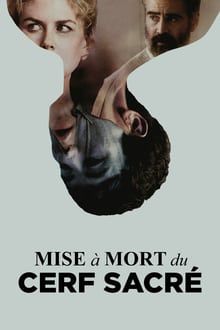The Big Picture
- Killing of a Sacred Deer follows a clear and direct narrative, with characters stating exactly what will happen and then letting it happen.
- The film does not focus on explaining the mechanics of the antagonist's actions but instead explores the question of why the events are happening.
- The ending of the film shows the main character accepting his fate and submitting to the forces beyond his control.
In some ways, The Killing of a Sacred Deer is Yorgos Lanthimos' most direct, explicitly stated narrative taken to its most direct, explicitly clear ending to date. Martin (Barry Keoghan) tells Dr. Steven Murphy (Colin Farrell) that, in light of Steven botching Martin's father's surgery resulting in his death, Steven's family (Nicole Kidman, Raffey Cassidy, Sunny Suljic) will die from a mysterious illness with mysterious symptoms, unless Steven himself chooses one to kill. The family starts experiencing all of these symptoms (paralysis, lack of appetite, eyes bleeding), no matter what Steven does. So, Steven spins in a circle with a hat over his eyes and randomly shoots and kills his son Bob (Suljic). In the final scene, we see the Murphy family minus Bob at a diner. Martin walks in, looks at them without their youngest. And, satisfied, leaves the diner and leaves them be.
Totally makes sense, right? Uh...
Yes, from a nuts-and-bolts storytelling standpoint, Lanthimos and co-writer Efthymis Filippou's screenplay has its characters say exactly what's gonna happen and then proceeds to let it happen. And thankfully, the film is not interested in the mechanics of how Martin can mystically will this poor family to undergo these horrors -- while the film ramps up in pace as Steven tries to stop Martin's actions, even resorting to kidnapping and torture, there is never a plot to uncover the "how" of his actions. No grand conspiracy, no examination of Martin's past, no revelation of mythological superpowers. The closest moment we get to this kind of explanatory detective work comes from Steven's wife Anna (Kidman) discovering through Steven's partner Matthew (Bill Camp) that Steven was likely drunk during Martin's father's surgery -- revealing not the source of Martin's "powers," but further "reason" that Steven deserves to be punished.
However, there is still much to discuss about Sacred Deer's ending, outside of the irrelevant "how" of Martin's grip over the Murphy family. Namely, "why?" A question that everyone in the Murphy family seems interested in asking and accepting -- from Anna's examination of Steven's past sins to the children's complete willingness to take what's happening at face value. The person who takes the longest to ask the question and accept his answer? Steven. And that just might explain his fate.

The Killing of a Sacred Deer
Steven, a charismatic surgeon, is forced to make an unthinkable sacrifice after his life starts to fall apart, when the behavior of a teenage boy he has taken under his wing turns sinister.
- Release Date
- November 3, 2017
- Director
- Yorgos Lanthimos
- Cast
- Colin Farrell , Nicole Kidman , Barry Keoghan , Sunny Suljic , Denise Dal Vera
- Runtime
- 121 minutes
- Main Genre
- Drama
'The Killing of a Sacred Deer' Has Mythological Roots
"Fate" is not a word chosen lightly. The Killing of a Sacred Deer is directly concerned with fate, with cosmic punishment of human hubris, with our so-called free will crumbling under the uncaringly cruel banalities of the universe. In exploring these themes, the film is reminiscent of a modern update on a Greek tragedy. And wouldn't you know it, Sacred Deer is inspired by an ancient Greek tragedy: Euripides' "Iphigenia in Aulis" (called out by Lanthimos and Filippou directly, in revealing that Cassidy's Kim wrote an essay on Iphigenia for her high school class).
In the play, part of a trilogy Euripides wrote in his final years on earth, Agamemnon ponders whether to sacrifice his daughter Iphigenia to the goddess Artemis, who is purposefully stopping proper winds for Agamemnon's fleet to successfully complete their invasion of Troy. Unfortunately, Agamemnon's fatal sin is Vanity -- after the first wave of battles against Troy, he boasted that he was as skilled a battler as Artemis herself. As you might imagine, Artemis didn't like that too much, demanding the blood sacrifice to bring Agamemnon back to earth. After a furious debate among his family and fellow generals, Agamemnon decides to undergo the sacrifice, reasoning that angry Greeks eager for victory would kill his entire family if he didn't.

Yorgos Lanthimos on ‘The Killing of a Sacred Deer’ and His Next Film, ‘The Favourite’
Watch our in-depth conversation with director Yorgos Lanthimos about the way he likes to work on set, if he’s ever made any significant changes to a film based on early screenings, and so much more.'The Killing of a Sacred Deer Improves Upon Its Source
In some manuscripts and translations of the play, though it's up for debate whether it's part of Euripides' original texts, Agamemnon surprisingly decides to pull a final trick on this plan, replacing his daughter Iphigenia with a sacred deer. Applying this ancient story to Lanthimos' work feels like enough of a 1:1 translation to start. Steven is Agamemnon. His sin of hubris translates into Steven's reckless drinking and displays of wealth. Martin is both Artemis, desiring the balance-restoring sacrifice, and the threat of Grecians killing Steven's family if he doesn't go through with it. But Lanthimos and Filippou aren't interested in just adapting this Greek myth. In fact, they're interested in correcting it. There's no switch for a sacred deer in the final moments of Sacred Deer. No tricks, no weaseling out.
After spending nearly two hours agonizing over how to best the unwavering hand of fate, how to make unequal the ever-equalizing force of universal retribution, and ignore the voices of "reason" around him (i.e. his daughter falling in love with Martin and begging to be the one sacrificed as well as his wife helping Martin escape), Steven gives in to as pure a fate as he can muster. Namely, he puts on a damn hat and spins in a damn circle to decide who he'll kill. That's about as random, as meaningfully meaningless, as admitting subservience to controllers beyond our control as you can get. Artemis wins.
In several moments of the film, Steven's family tries to reassert Steven as the man in charge, rather than Martin, to try and pivot to another method of escaping fate. Anna "logically" points out that killing one of the children is a better choice because they can have another. Bob cuts his own hair, placating Steven's early-film grumblings that his hair is too long. Even in the face of an unblinking God, we humans will search for any Earthly source of relief telling us it's okay to blink. From the first shot to its last, Lanthimos' Killing of a Sacred Deer is here to remind us that the universe will come to collect, and its eyes are forever wide open.
The Killing of a Sacred Deer is currently streaming on Netflix in the U.S.

